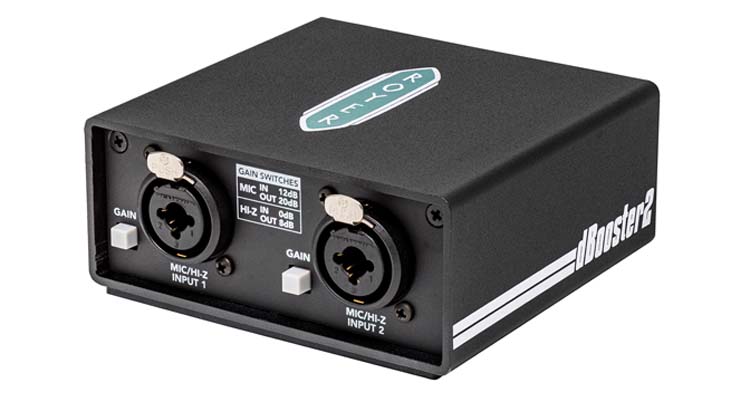Royer Labs Announces Second Generation of In-line Signal Booster, dBooster2
 Royer Labs announced the second generation of its in-line signal booster, the dBooster2. In addition to being a phantom-powered signal booster and impedance buffer for both ribbon and dynamic microphones, the second generation dBooster2 offers independent two-channel functionality and doubles as a DI to accommodate signal levels for electric guitar, bass and other unbalanced guitar level sources. Both channels have the ability to serve as an in-line signal booster, a DI or one channel of each. The dBooster2 is great for miking low volume sound sources, recording direct to a DAW interface, interfacing with long cable runs to maintain audio quality or as a DI.
Royer Labs announced the second generation of its in-line signal booster, the dBooster2. In addition to being a phantom-powered signal booster and impedance buffer for both ribbon and dynamic microphones, the second generation dBooster2 offers independent two-channel functionality and doubles as a DI to accommodate signal levels for electric guitar, bass and other unbalanced guitar level sources. Both channels have the ability to serve as an in-line signal booster, a DI or one channel of each. The dBooster2 is great for miking low volume sound sources, recording direct to a DAW interface, interfacing with long cable runs to maintain audio quality or as a DI.
When used as a signal booster, Royer Labs says both channels of the dBooster2 increase the level of passive low-output ribbon and dynamic microphones with minimum distortion or coloration. Created for pro applications, the dBooster2’s input stages are designed like the front end of a high-end microphone preamplifier. Each dBooster2 channel offers two levels of clean gain boost in Mic Mode, selectable by a front panel switch: 12dB or 20dB. The dBooster2’s Class A input presents a high source impedance to microphones, minimizing loading (damping) and improving headroom. By utilizing the 12/20dB gain switch, optimum balance between gain and headroom can be achieved.
When used as a DI for unbalanced guitar level sources, the dBooster2 provides either 0dB or 8dB of gain, selectable from the front panel switch. The single-ended high-impedance (230K-Ohm) DI input maintains headroom and gain regardless of load, with minimal distortion or coloration. Regardless of whether the dBooster2 is functioning as a signal booster or DI, the unit’s low-impedance outputs provide the ability to drive digital interfaces or standard mic preamps. Equally notable, the dBooster2 minimizes signal loss over long cable runs.
Royer’s new dBooster2 is safe for use with all ribbon microphones, protecting the ribbons from phantom power hits, providing increased headroom at the preamp and giving true electrical isolation. Each channel operates independently and is electrically isolated from the other. This compact device can drive difficult loads such as mic splitters and vintage-style preamps without loss of gain or increased distortion.


